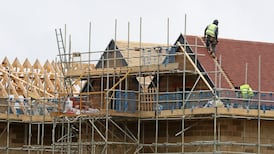Wholesale gas prices have surged due to fears of further interruptions in the supply of gas from Russia, rising another 4.5 per cent on Tuesday and approaching record levels reached after Russia invaded Ukraine in February.
On European markets prices are now about €172 per megawatt hour, with a sharp rise in recent weeks from the €80-€100 level at which futures were trading between May and mid-June. Significantly, the futures market is now indicating that high prices around current levels will persist well into next year, with the whole market having effectively repriced because of mounting threats to supply.
The latest price rise is due to fears about supply through the Nord Stream 1 pipeline, the biggest carrier of Russian gas to Germany. Russia has already restricted flows through the pipeline, which closed on Monday for annual maintenance, due to take about 10 days. Speculation in Europe that the gas may not be turned back on has led to fears of shortages and wholesale gas prices spiking further.
German industry would be hard hit by a cut off of Nord Stream supplies which, if sustained, would be likely to push the EU economy into recession.
READ MORE
Any further restriction in Russian gas supply would reduce the EU’s ability to fill its gas shortage facilities before the key winter period. Already Russia has restricted supplies through the Nord Stream pipeline since mid-June to 40 per cent of capacity, putting pressure on big gas supply companies that were forced to buy on the spot market at inflated prices.
It remains unclear what Russia will do after the routine maintenance period is completed next week. Some analysts believe supply will resume for now, but that Russian president Vladimir Putin would retain gas as an economic “weapon” moving into the winter period.
Ireland does not rely on supplies from Russia but industry and consumers are now exposed again as wholesale prices rise further, which will — if maintained — feed through to higher retail prices and increased costs for business. Gas-fired stations also provide close to half of all electricity produced in Ireland and are the vital backstop to the system, especially in calm periods when little energy is generated by wind.
About 75 per cent of Ireland’s natural gas supply comes via pipelines from the UK, while the rest comes from the Corrib field, where output is gradually declining.
With the UK supplied from the North Sea and Norway, its National Grid operator says it has a steady supply of gas. Some Norwegian gas comes to the UK via a direct pipeline, but Norway could come under pressure from EU countries it supplies to divert some gas to them and away from the UK in the event of a big shortage, though this would also depend on the capacity of existing pipelines.
In the event of any shortage the UK National Grid has said that Ireland would be treated on the same basis as the domestic UK market under current agreements. However, even if the supply of gas remains available, a cut off of Russian gas would be likely to say prices remain at very high levels, with a big economic and social impact.














